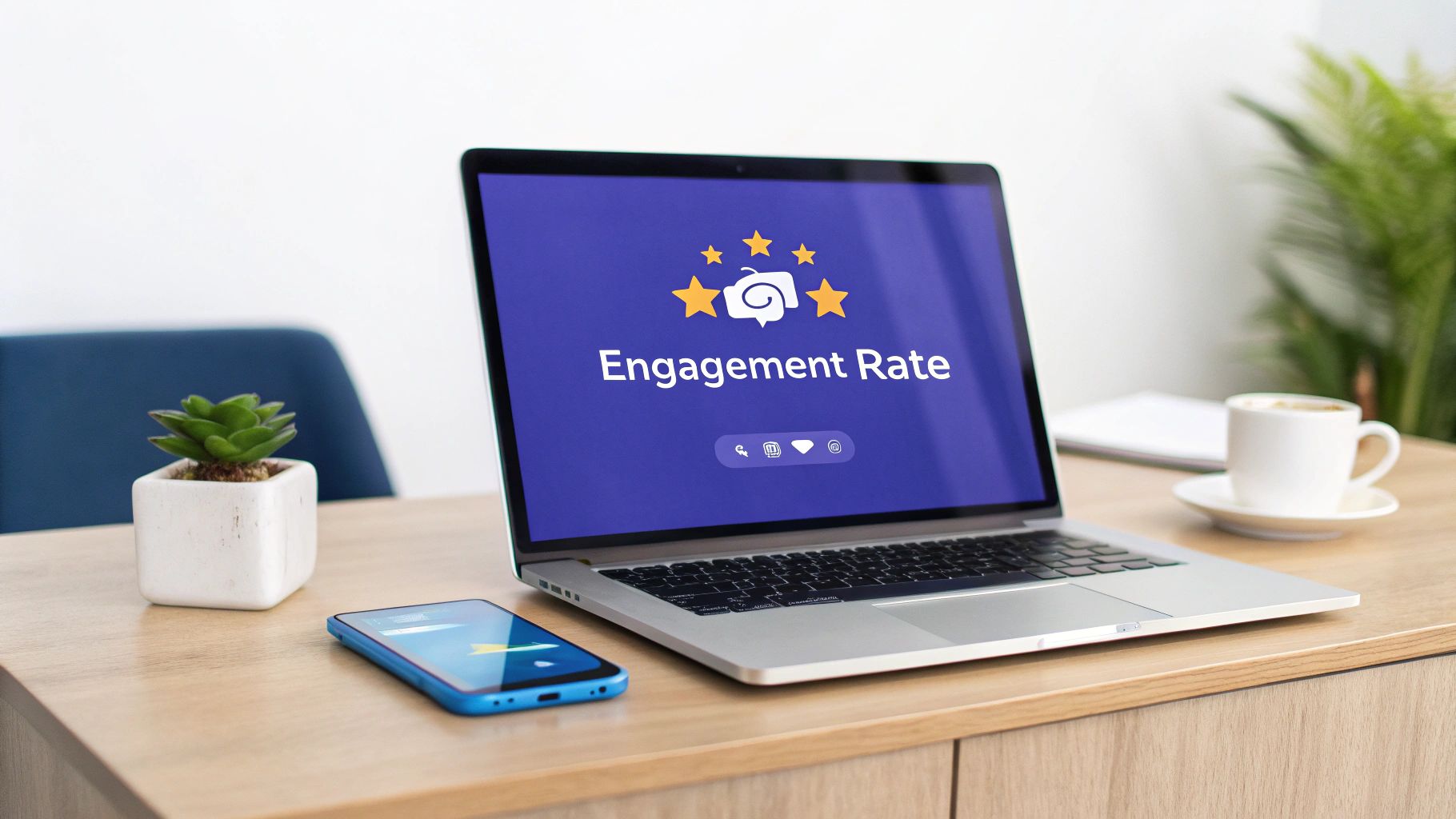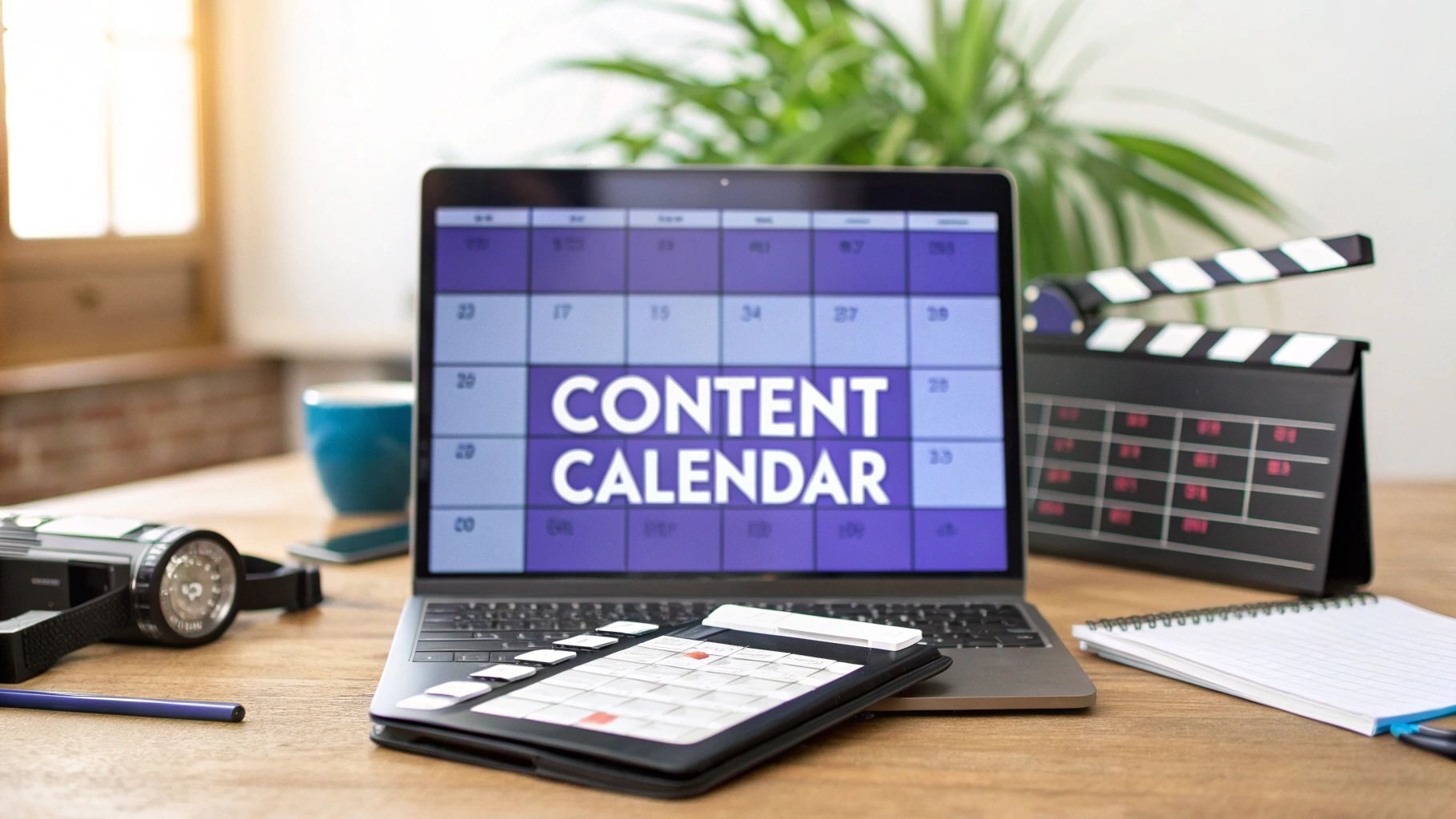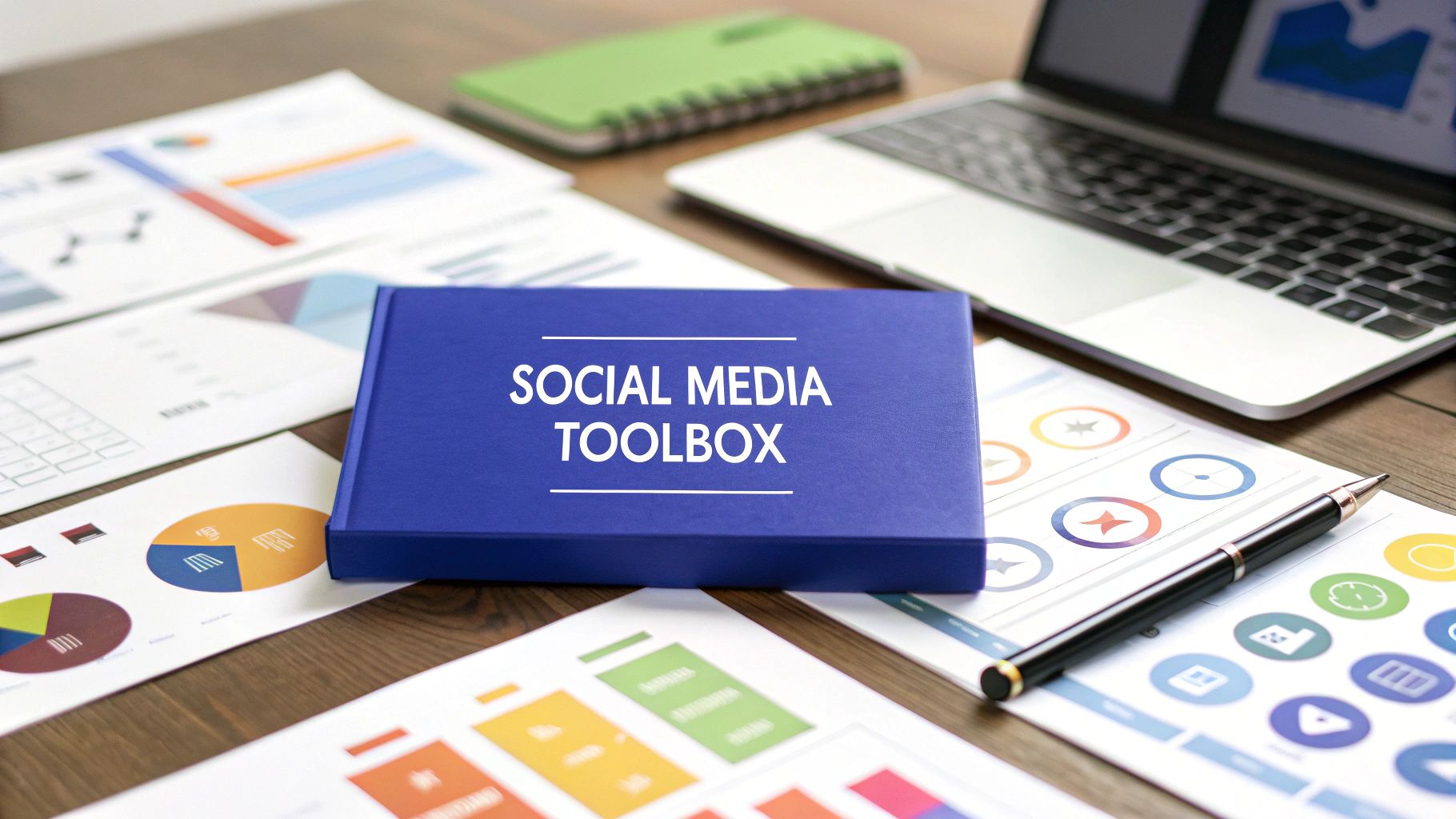Engagement rate is the metric that tells you how many people are actually interacting with your content. It’s a simple percentage that cuts through the noise of vanity metrics to reveal how connected your audience is to what you're posting.
Why Engagement Rate Is Your Most Honest Metric
Let's be real: follower count can be a vanity metric. Having a massive audience looks great on paper, but it doesn't mean a thing if nobody is actually listening. This is where your engagement rate becomes your most trusted advisor—it's the ultimate measure of your audience's genuine connection to your brand.
Think of it like this: your follower count is the number of people in a room. Your engagement rate tells you who is leaning in, nodding along, asking questions, and sharing your stories with their friends. It’s the difference between shouting into an empty canyon and captivating an active, buzzing crowd.
Beyond Likes and Follows
True engagement is a powerful mix of different interactions that signal real interest. It's not just about a quick "like." It's a much bigger picture of how your audience behaves, and these actions are the bedrock of a loyal community.
Here are the key building blocks of engagement:
- Likes or Reactions: The simplest nod of approval. It’s the easiest way for someone to say, "I see you, and I like this."
- Comments: This is a much stronger signal. It means your content was interesting enough to make someone stop, think, and type out a response.
- Shares or Retweets: The ultimate endorsement. Someone found your content so valuable they were willing to stamp their name on it and show it to their own network.
- Saves: This is a huge deal, especially on platforms like Instagram. It means your content is so useful that people want to come back to it again and again.
- Clicks: A clear sign your call-to-action worked. You didn't just grab their attention—you convinced them to take the next step.
The True Value of an Engaged Audience
A high engagement rate isn't just a feel-good number for your reports. It’s a direct reflection of your brand's health and your audience's loyalty. When people consistently interact with your content, it signals to the platform algorithms that what you're posting is valuable. The reward? More organic reach.
This creates a fantastic feedback loop: great content gets seen by more people, which in turn generates even more engagement.
Better yet, an engaged community is a powerful business asset. These are the people who are most likely to become your customers, champion your brand, and give you priceless feedback. They're your true supporters. By focusing on your engagement rate, you move from just broadcasting messages to building a real, thriving community. And tracking all the different social media engagement metrics is the first step to figuring out what truly clicks with your people.
Key Engagement Rate Formulas at a Glance
There isn't just one way to calculate engagement. Depending on what you want to measure—the impact of a single post or the effectiveness of a paid campaign—you'll use a different formula.
Here’s a quick-glance table to make sense of the most common ones.
| Formula Name | Calculation | Best Used For |
|---|---|---|
| Engagement Rate by Reach | (Total Engagements / Total Reach) * 100 | Measuring how compelling your content is to the unique people who actually saw it. |
| Engagement Rate by Post | (Total Engagements on a Post / Total Followers) * 100 | Assessing a post's performance relative to your existing follower base. |
| Engagement Rate by Impressions | (Total Engagements / Total Impressions) * 100 | Evaluating the effectiveness of your content, especially useful for paid ad campaigns. |
Each formula tells a slightly different story, so choosing the right one depends entirely on the question you're trying to answer about your performance.
How to Correctly Calculate Engagement Rate
Everyone talks about engagement, but what does it really mean? Knowing the value of a like or a share is one thing, but being able to measure it accurately is where a real strategy begins.
The truth is, there's no single, one-size-fits-all formula. Different calculations tell you different stories about how your content is performing. Choosing the right one is the key to getting clear, actionable insights instead of just vanity metrics.
Let's break down the three most important formulas you need to know. Each one serves a unique purpose, whether you're trying to figure out if your content is actually interesting, how it lands with your core followers, or how effective your ad spend is. Get these down, and you'll be able to measure what truly matters.
Engagement Rate by Reach (ERR): The Gold Standard
First up is Engagement Rate by Reach (ERR). In my experience, this is the most honest way to measure how compelling your content is.
Why? Because it’s based on the number of unique people who actually saw your post—not just your total follower count. This method cuts through the noise of the algorithm to give you a pure look at content quality. If a post goes viral and reaches tons of new people, ERR will show that success. On the other hand, if a post has a bad day with the algorithm, this formula won't unfairly punish your numbers.
The formula is clean and simple:
ERR = (Total Engagements / Total Reach) x 100
So, let's say your post gets 100 likes, 50 comments, and 20 shares (that's 170 engagements) and it reached 10,000 people. Your engagement rate would be 1.7%. This little number tells you a whole lot about how people behave the moment they see your content. For a deeper dive into how different formulas give you context, you can check out this guide on measuring social media engagement.
Engagement Rate by Post (ER Post): A Follower-Focused View
Next, we have Engagement Rate by Post (ER Post). This formula is all about your loyal community.
It measures a post's interactions against your total number of followers. This is a great way to keep a pulse on how your core audience—the people who chose to follow you—are responding to your content, one post at a time. It's a quick and easy health check for your community's interest level.
The main drawback? It doesn't factor in viral reach at all. A post could reach a million people, but this formula only compares its likes and comments to your static follower count, which can make a successful post look mediocre.
Here’s how you calculate it:
ER Post = (Total Engagements on a Post / Total Followers) x 100
Imagine your account has 20,000 followers and a post gets 400 total engagements. Your ER Post would be 2%. This tells you that 2% of your entire follower base took the time to interact with that specific piece of content.
Each of those interactions—the likes, comments, and shares—is a signal that you're building a real connection with your audience.
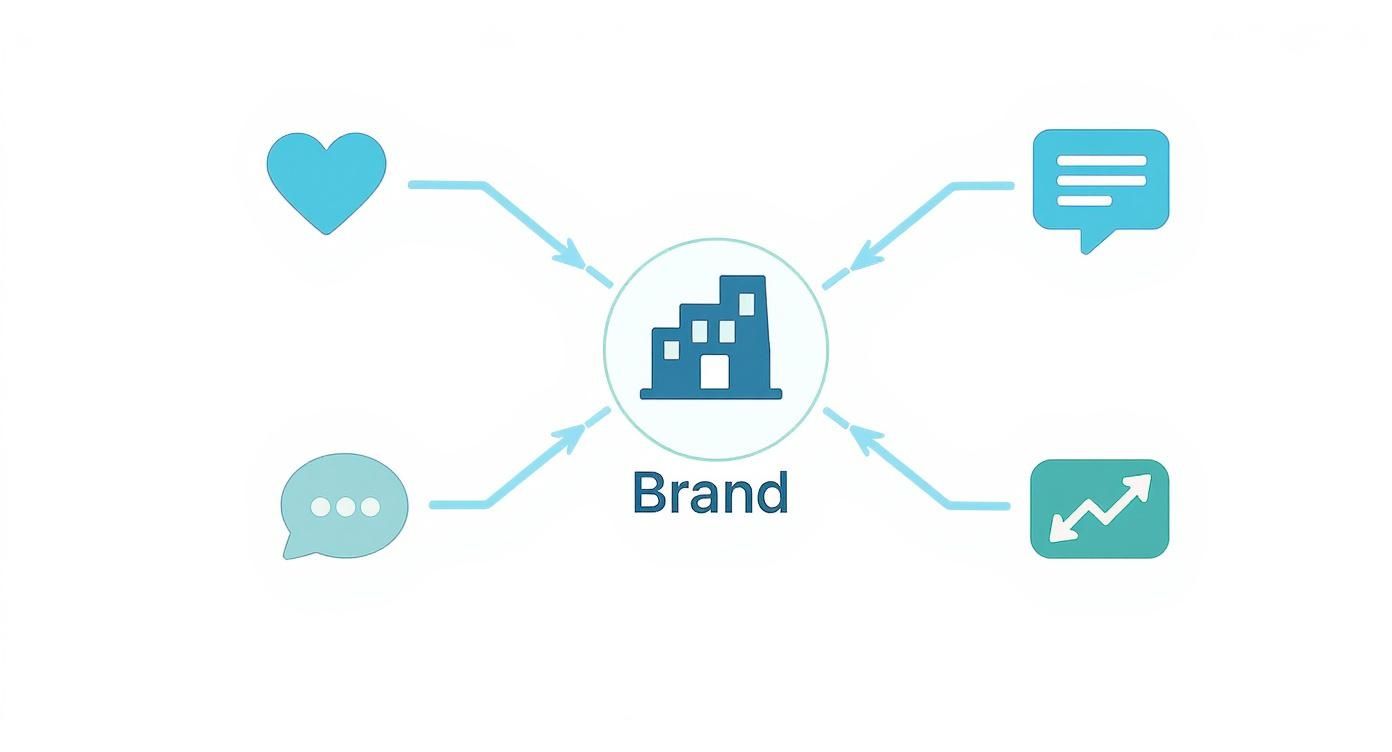
Ultimately, every single engagement is a sign that people are paying attention and finding value in what you're putting out there.
Engagement Rate by Impressions (ER Impressions): For Paid Campaign Clarity
Finally, there's Engagement Rate by Impressions (ER Impressions). This one is your best friend when you’re running paid campaigns.
This formula measures engagement against the total number of times your content was displayed, even if the same person saw it multiple times. That's why it's so valuable for paid social—where you're often paying per impression.
Think about it this way: Reach counts unique viewers, but impressions count every single view. If one person sees your ad five times, that’s five impressions but only one person reached. Calculating engagement against impressions tells you how effective your ad is at grabbing attention each time it appears on someone's screen.
The formula looks like this:
ER Impressions = (Total Engagements / Total Impressions) x 100
Let's say you run an ad that gets 50,000 impressions and racks up 1,000 engagements. Your ER Impressions would be 2%. This metric is perfect for A/B testing ad creatives because it shows you exactly which version drives more interaction per view.
Setting Realistic Engagement Benchmarks
So, you’ve got the formulas down and you’re cranking out the numbers. Now for the million-dollar question: what does a "good" engagement rate actually look like?
Trying to compare your performance without the right context is a fool's errand. It’s like comparing a sprinter to a marathon runner—they’re both running, sure, but their goals and metrics for success are wildly different.
Setting realistic benchmarks is everything. It’s what stops you from chasing impossible vanity metrics or, just as bad, patting yourself on the back for mediocre results. A 3% engagement rate might be stellar on one platform but a serious red flag on another. Why? Because every social network is its own little universe with unique user behaviors, content formats, and algorithms.
Why Platform Averages Differ So Drastically
If you want to set smart goals, you need to understand the "why" behind the numbers. It really boils down to two things: user intent and platform design.
Think about it. When someone logs into LinkedIn, they're usually in a professional mindset. They’re there to network, catch up on industry news, and learn something new. This naturally leads to more thoughtful interactions like comments and shares.
Contrast that with someone scrolling through Instagram or TikTok. They're often in a more passive, entertainment-seeking mode, flicking through bite-sized visuals at lightning speed. In that environment, you have a fraction of a second to grab their attention, which is why average engagement rates tend to be lower, even for amazing content.
The big takeaway here is to stop applying a one-size-fits-all benchmark to all your social channels. A winning strategy means tailoring your expectations—and your goals—to the unique culture of each platform.
A Snapshot of Social Media Engagement Averages
To give you a clearer picture, let's look at some recent data. As of early 2025, the average engagement rates are all over the map.
Here’s a quick overview of what the landscape looks like.
Average Engagement Rate by Social Media Platform
A comparative overview of the average engagement rates across the major social networks, helping marketers set realistic benchmarks for their strategy.
| Platform | Average Engagement Rate | Primary Content Type |
|---|---|---|
| 6.50% | Professional Articles, Text Updates, Video | |
| 5.07% | Mixed Media, Community Updates, Video | |
| 1.16% | Images, Reels, Stories | |
| X (Twitter) | 0.035% | Short Text, Breaking News, Memes |
| TikTok | 4.25% | Short-Form Video |
Source: Data aggregated from multiple industry reports, early 2025.
These numbers make it crystal clear why comparing your Instagram performance to your LinkedIn results is a recipe for a bad analysis. They serve completely different purposes and attract entirely different kinds of interaction. You can explore more social media statistics to see the full landscape of platform performance.
- LinkedIn (6.50%): Professionals are here to engage with quality content, making them more likely to comment and share things they find insightful.
- Facebook (5.07%): With its strong community features and a wide variety of content types, it encourages a broad range of interactions from likes to long-form comments.
- Instagram (1.16%): The sheer volume of visual content and the fast-scrolling culture lead to more passive "likes" than deep, meaningful engagement.
Digging Deeper Into Platform Specifics
Beyond these broad averages, every platform has its own quirks.
X (formerly Twitter) is built for rapid-fire conversations. Retweets and replies are the currency of the realm, and the fast-moving feed means most content has a very short shelf life. This can naturally affect the overall numbers you see.
TikTok is another beast entirely. Its algorithm is legendary for a reason—it can take a video from a totally unknown creator and make it a viral hit overnight. Because view counts can get so massive, a "good" engagement rate is often measured differently. If you really want to succeed there, you need to understand its specific dynamics. For instance, learning what is considered a good engagement rate on TikTok is less about followers and more about things like views-to-likes ratios and share velocity.
Ultimately, these benchmarks are just a starting point, not the finish line. The most important comparison you can ever make is against your own past performance. Your real goal should be steady, incremental improvement, month after month. Use these industry averages as a guidepost to see where you stand, but focus on beating your own best.
Common Mistakes in Tracking Engagement
So you're tracking your engagement rate—that's a huge step in the right direction. But just pulling numbers without understanding what they really mean can send your strategy spiraling. It's easy to fall into a few common analytical traps, and knowing how to spot them is what separates smart analysis from flawed assumptions.
Let's walk through four critical mistakes I've seen even seasoned marketers make. Once you know what to look for, you can make sure your data is telling you the whole truth.
Mistake 1: Comparing Apples to Oranges
This one is probably the most common blunder: comparing engagement rates across totally different platforms. As we've covered, a 6% rate on LinkedIn is phenomenal, but that same number would be an absolute home run on Instagram. Each platform is its own little world, with its own user base, algorithm, and culture of interaction.
- The Error: A brand manager sees their Instagram engagement is hovering at 1.2% while their LinkedIn is a healthy 5.5%. They immediately think the Instagram strategy is broken and start shifting resources away from it.
- The Fix: You have to benchmark each platform against itself. Judge your Instagram's success against other Instagram accounts in your niche and your own past performance. Don't compare it to your LinkedIn page—it’s a different game entirely.
The goal isn't to get the same number everywhere. It's to excel within the unique environment of each platform. Treat every channel as its own ecosystem with its own rules for success.
Mistake 2: Misinterpreting Viral Content
It’s an amazing feeling when a post goes viral, but this is where the math can get tricky. If you use the standard follower-based formula (ER Post), you might accidentally make a huge success look like a failure. A post that blows up and reaches millions of non-followers will naturally have a lower engagement rate relative to your follower count, which is incredibly misleading.
- The Error: An account with 10,000 followers creates a post that gets 5,000 engagements but reaches 500,000 people. Using the follower formula gives you a 50% engagement rate, which is just unrealistic. On the flip side, a skeptical marketer might see the engagement is "only" 1% of the total reach and write off the viral hit.
- The Fix: For any post that gets significant reach outside your followers, always use Engagement Rate by Reach (ERR). It’s the only formula that accurately shows how compelling your content was to everyone who saw it, not just your established audience.
Mistake 3: Ignoring the Context Behind the Numbers
This is a big one. High engagement isn't automatically a good thing. What if a post is controversial, confusing, or just plain offensive? It might rack up hundreds of comments, but if they're all from angry customers, that "high engagement" is really a brand crisis unfolding in public.
Numbers without context are just noise.
- The Error: A company drops a poorly worded statement and gets 500 comments, making its engagement rate for the day skyrocket. The social media manager, looking only at the spreadsheet, reports a "highly engaging post" without realizing the comments are overwhelmingly negative.
- The Fix: You have to look beyond the raw numbers and dig into the quality of the interactions. Are people excited? Confused? Upset? A quick scroll through the comments or a sentiment analysis tool will tell you the story behind the stats. A post with 20 thoughtful, positive comments is infinitely more valuable than one with 200 angry reactions.
Mistake 4: Failing to Segment Your Data
Treating all your content like it's the same is another critical error. It’s a safe bet that your audience interacts differently with videos than they do with carousels or simple text posts. When you lump all that data together, you’re hiding the very insights that could help you improve.
- The Error: A brand's overall engagement rate is a flat 2.5%. The team keeps pumping out the same mix of content, completely unaware that their video posts are actually averaging 5% engagement while their static images are dragging the average down at 1%. They're sitting on a winning format and don't even know it.
- The Fix: Break down your analytics. Segment your reports by content type, campaign, or even specific topics. When you isolate the variables, you can clearly see what’s working and what’s not. This is how you find your top-performing formats, double down on them, and systematically raise your overall average.
Actionable Strategies to Improve Your Engagement Rate
Knowing your engagement rate is one thing; making it grow is the real goal. Boosting engagement isn't about finding a single magic trick. It's about consistently applying smart, audience-focused tactics that genuinely invite interaction.
Forget vague advice like "be more authentic." Let's get into concrete strategies you can start using today. These methods are designed to work with audience psychology and platform algorithms to spark real conversations and build a more active community.
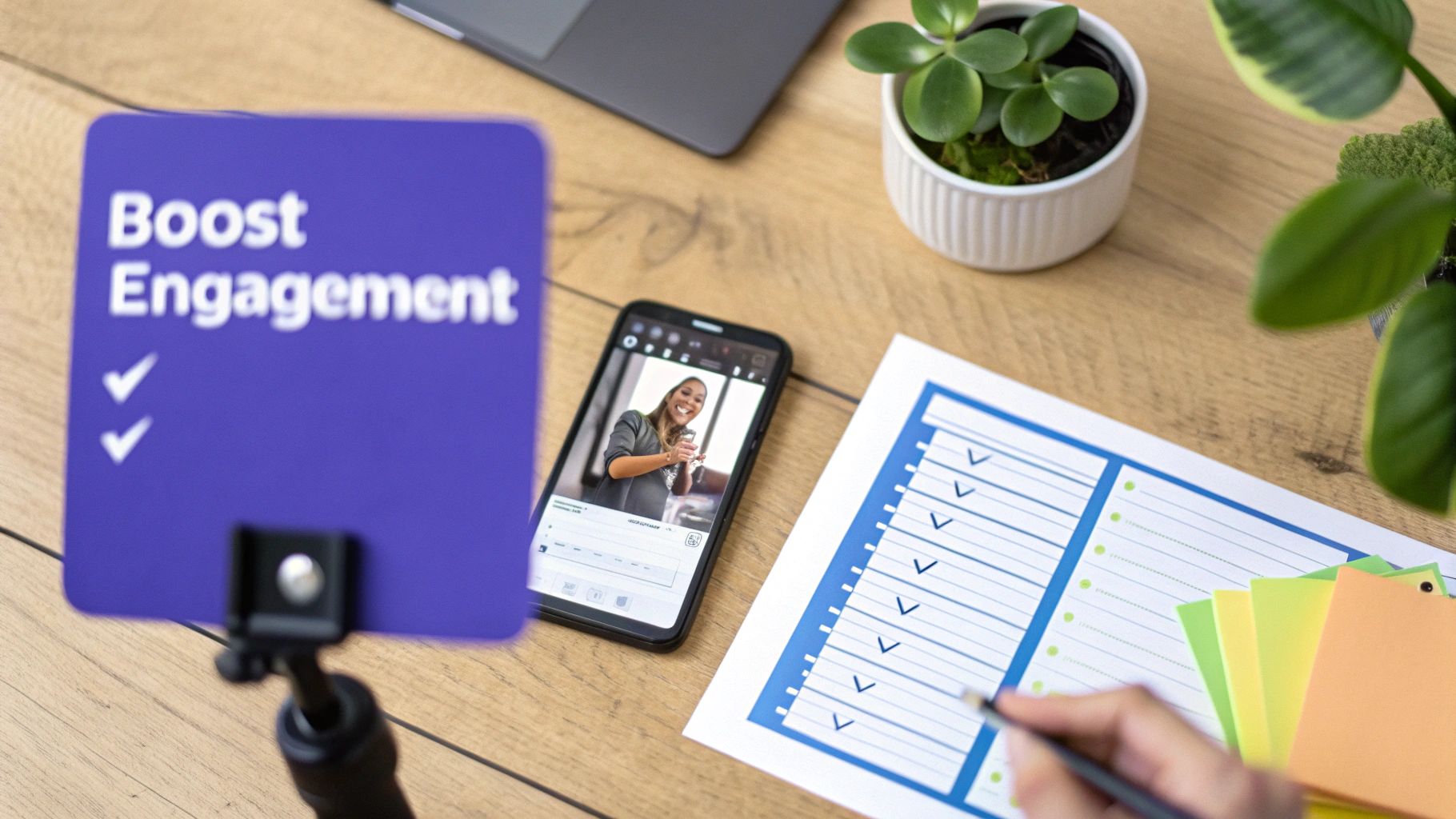
Master the Art of the Hook
In an endless scroll, you have less than three seconds to grab someone's attention. A powerful hook is non-negotiable, especially for video on platforms like TikTok and Instagram Reels. Your first few moments have to create curiosity or deliver an immediate promise of value.
Think about starting your videos with:
- A Bold Statement: "Most marketers get this one metric completely wrong."
- An Intriguing Question: "What if you could double your engagement in 30 days?"
- A Visual Surprise: An unexpected action or a stunning clip that makes people stop and wonder what’s happening.
That initial grab is what earns you the next few seconds of viewership—and that's often all the algorithm needs to see that your content is worth pushing to more people.
Write Captions That Start Conversations
A great visual might stop the scroll, but a compelling caption turns a passive viewer into an active participant. Your goal is to move beyond simple descriptions and write copy that actively demands a response.
One of the most effective ways to do this is to end your caption with an open-ended question. Steer clear of simple "yes" or "no" questions.
Key Insight: Don't just ask if your audience agrees. Ask them why or how. A question like, "Which of these tips will you try first and why?" generates far more detailed and valuable comments than "Did you find this helpful?"
This approach does more than just boost your comment count. It gives you priceless audience feedback—a direct line into their thoughts, challenges, and preferences.
Leverage Interactive Platform Features
Modern social media platforms are packed with tools designed specifically to drive interaction. Using them is one of the easiest ways to lift your engagement rate because they give your audience a low-effort way to get involved.
Here are a few features you should be using regularly:
- Polls: Ask your audience to vote on new product ideas, content topics, or simple "this or that" questions.
- Quizzes: Create fun, interactive quizzes that test your audience's knowledge about your industry or brand.
- Q&A Stickers: Use these on Instagram Stories to invite questions, which you can then answer in later content.
- "Add Yours" Prompts: Start a content chain on Instagram where users can add their own photo or video based on your prompt.
These features transform your content from a one-way broadcast into a two-way conversation, signaling to the algorithm that your account is a hub of community activity.
Create Content Designed to Be Saved
While likes and comments are great, a "save" is one of the most powerful engagement signals you can get. It tells the algorithm your content is so valuable that a user wants to come back to it later. It's a massive indicator of high-quality, useful content.
To encourage saves, focus on creating high-utility posts.
- Checklists: Step-by-step guides that users can follow.
- Tutorials: Detailed how-to guides that solve a specific problem.
- Resource Lists: Curated lists of tools, books, or tips.
- Inspirational Quotes: Content that people want to save for a dose of motivation.
When you create this type of content, add an explicit call-to-action like, "Save this post for later!" This simple reminder can make a huge difference in how many saves you get. For a deeper dive into these and other tactics, our complete guide offers many more ways to improve your social media engagement. This systematic approach ensures your strategy isn't just about getting views—it's about becoming an indispensable resource for your followers.
Beyond Spreadsheets with Analytics Tools
Let's be real: trying to manually calculate every engagement formula for every post across all your platforms is a nightmare. It's a surefire way to make mistakes, waste hours, and completely miss the bigger picture. Spreadsheets can hold numbers, sure, but they can't tell you the story behind them.
This is exactly why smart marketers move beyond the spreadsheet. Modern social media analytics tools don’t just hold your data; they make sense of it for you, shifting your focus from tedious data entry to genuine strategy.
Tools like PostSyncer handle all the heavy lifting. They pull in data from all your accounts and pop it into a single, clean dashboard. Instead of wrestling with formulas yourself, you get instant, accurate engagement rates for every metric that matters. This frees you up to do what you do best: understand what your audience wants and create content that truly connects.
From Raw Data to Actionable Insights
The real magic of these tools is how they turn endless rows of numbers into something you can actually use. They transform raw data into simple, visual charts and graphs that immediately show you what’s hitting the mark and what’s falling flat.
This visual-first approach makes it incredibly easy to:
- Identify Your Greatest Hits: Instantly see which posts, videos, or campaigns are sparking the most conversation and interaction.
- Spot Performance Trends: Are you on an upward swing? A visual timeline of your engagement growth tells you at a glance if your strategy is working.
- Benchmark Against the Competition: See how your engagement stacks up against others in your space. This context is vital for knowing if you're leading the pack or falling behind.
For example, a dashboard can lay out your engagement rates side-by-side for each platform.

A simple view like this immediately tells you where to pour your creative energy for the biggest impact.
Making Smarter Strategic Decisions
At the end of the day, just knowing what is engagement rate isn't enough. The real goal is to use that knowledge to grow. A dedicated analytics platform centralizes everything you need to make confident, data-backed decisions. And to get the full picture of your online performance, it's wise to look beyond just social media; check out these other key website metrics to track to get a more holistic view.
By automating the math and highlighting key trends, these platforms give you back your most precious resource: time. You can spend less of it buried in spreadsheets and more of it creating the kind of content your audience can't wait to see.
If you're ready to make the switch, our guide to the best social media analytics tools can help you find the right fit for your team. Moving from manual tracking to automated insights isn't just a convenience—it's essential for any brand that's serious about building a community that cares.
Answering Your Top Engagement Rate Questions
Even after you've got the formulas down, some real-world questions always pop up. It's one thing to know how to calculate engagement, but another to know what the numbers really mean for your strategy. Let's tackle some of the most common questions marketers have.
What’s a “Good” Engagement Rate, Anyway?
This is the million-dollar question, and the honest answer is: it depends. There's no magic number. While you'll often hear 1% to 5% thrown around as a decent benchmark, that range is so broad it's almost useless without context.
Think of it this way: a 6% engagement rate on a professional platform like LinkedIn is fantastic. But on Instagram, where interactions are more frequent, that same 6% would be absolutely stellar. The best way to measure "good" is to stop looking at universal numbers and start benchmarking against what matters.
- Benchmark Against Yourself: Is your engagement rate higher this month than last month? That's progress. Focus on steady, incremental growth over time.
- Benchmark Against Your Rivals: Take a look at what direct competitors in your niche are pulling on the same platforms. This gives you a much more realistic target to aim for.
Is Engagement Rate More Important Than Follower Count?
Absolutely. A million followers who never like, comment, or share your content are just digital window shoppers. They might look impressive, but they don't contribute to your business goals. This is often the case with accounts that blew up from a one-off viral video or a big giveaway—the audience is wide but not deep.
On the flip side, a smaller, fired-up community is pure gold. These are the people who will buy your products, champion your brand to their friends, and give you honest feedback. They are your true fans.
Key Takeaway: Follower count is your potential audience. Engagement rate is your actual connection with them. One is a vanity metric; the other is a sign of a healthy, thriving brand.
How Often Should I Be Checking This?
For the big picture, calculating your overall engagement rate on a monthly and quarterly basis is the sweet spot. This rhythm is perfect for spotting trends, seeing if your strategy changes are working, and setting smart goals for the next period.
But for specific campaigns, you need to be more agile. If you're running a week-long promotion or A/B testing two different types of content, you’ll want to measure the engagement rate right after it ends to see what worked. While tools can give you real-time data, that structured monthly check-in is what keeps your strategy on track.
Do Negative Comments and Reactions Hurt My Engagement Rate?
Here's a tricky one. From a purely mathematical standpoint, no. An "angry" react on Facebook or a critical comment still counts as an engagement in the formula. The platform's algorithm just sees that your post is sparking conversation and might even show it to more people.
But this is where you have to look past the numbers. An engagement rate inflated by negative sentiment is a red flag for your brand's health. It's crucial to analyze the feeling behind the interactions, not just the raw count.
Ready to stop guessing and start growing? PostSyncer automates all your engagement calculations, visualizes your performance trends, and delivers the actionable insights you need to build a more connected audience. Ditch the spreadsheets and discover a smarter way to manage your social media. Start your free 7-day trial of PostSyncer today.
